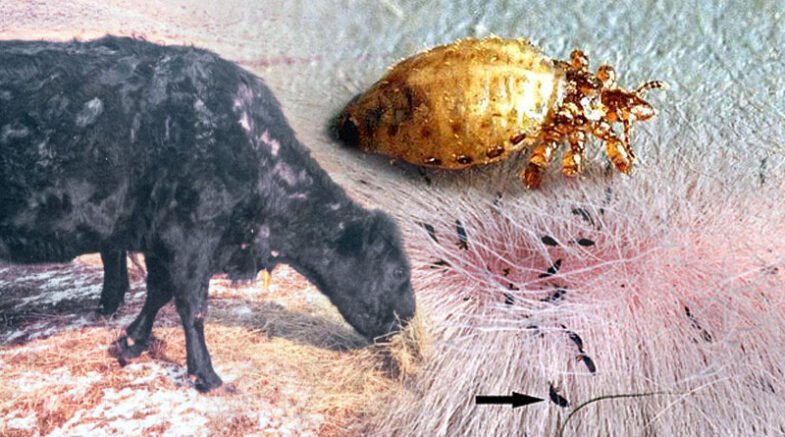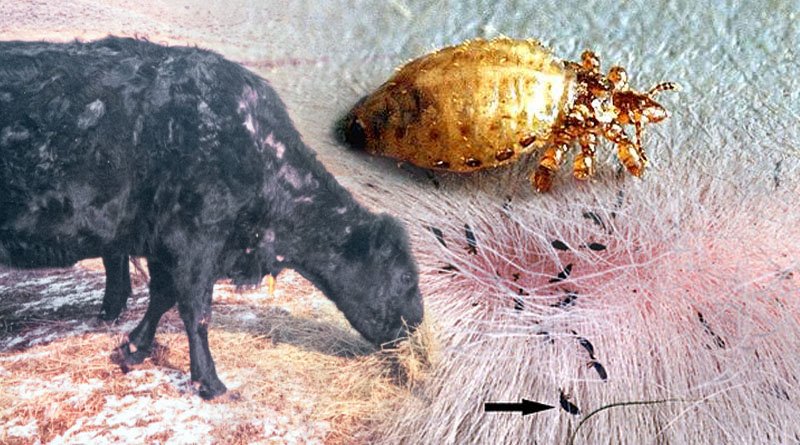There is a seasonal pattern in the occurrence of lice infestation in cattle, with populations tending to build in the cooler months of the year and decline during the hot summer.

Lice are small, dorsoventrally flat-bodied skin parasites with legs modified for grasping hairs. They are very specific to the host. Cattle louse can only parasitize cattle and is unable to survive on another host for more than a day or two. In the winter, lice infestation in cattle is common. The cooler skin and winter coat favor the attachment of lice to the skin
Lice are of two types: sucking louse and biting louse, sometimes also known as chewing louse.
As the name indicates, the sucking louse suckles the blood of the host by piercing through the skin, while the biting louse gets its feed by biting skin debris, hair, and oily secretions.
Both the sucking and biting louses are important from an animal welfare point of view, as they are a continuous source of irritation and nuisance to the cattle.
Lice infestation in cattle not only causes anemia and productivity loss but also low-quality hides due to biting, scratching and rubbing the skin against walls, fences and trees.
It is also reported that lice may transmit dermycosis, anaplasmosis and rickettsiosis.
The life cycle of louse is completed on the host. The female louse lays one or two eggs per day, glued to hair shafts close to the skin. Within 8 to 19 days, the eggs hatch into nymphs. The nymph undergoes three molts on the host, each lasting ten days, before she develops into an adult. The adult female lives about 42 days and lays up to 50 eggs in her life.
In cattle, the most prevalent biting louse is Bovicola bovis, reddish brown and 2 mm in length. It is usually found at the neck, shoulders, back and rump. Cattle infested heavily with biting lice can be diagnosed easily. The most obvious signs are rubbing the site of infestation against walls or fences and clumps of hair falling out. The scratch spots can be visualized on the body due to constant attempts of scratching. The hair become loose and fall off in result of a skin reaction.
The sucking lice of cattle with narrow, pointed heads include Haematopinus Eurystheus, commonly known as short nosed cattle louse, ranging in size from 3.5 to 5 mm. It is dark gray and can be found around the eyes, neck, and tail. The peculiar sign of short nosed cattle louse is the greasy appearance of cattle due to crushed lice and their feces, blood, and serum from wounds on the skin of cattle.
The other sucking louse is Linognathus vituli, 2.5 mm long with bluish black color and Solenopotes capillatus, the smallest louse, only 1.2 mm in size. The head is brown, but the abdomen is blue. The preferred site of this louse is around the head and neck. Although mixed infestations of biting and sucking lice are common, they can be distinguished visually on the animal.
For visual examination of the animal, you must bring the animal in the sunlight. Examine with a magnifying glass by parting the hair of animals; this will assist you in locating the lice as they move away from the sunlight. The biting lice can be recognized by their rounded heads, brown color, and tendency to move fast when parting the hairs, while the sucking lice appear gray or blue with pointed heads that tend to remain fixed to the skin.
The presence of eggs stuck to the shafts of hair can also be visualized. In severe cases, sucking lice get densely packed and create characteristic quarter-sized black or brown spots that are difficult to move or disturb by skin searches.
On the other hand, biting lice do not like to form clusters; they are very active and move rapidly in response to disturbances. These tiny insects are easy to overlook in light infestations unless carefully inspected. In the case of suspected light infestations, the farmer must inspect the preferred areas of lice infestation.
Lice are passed from one cow to another through direct contact. This is especially true on farms where many cows are kept in small sheds. The lice are host-specific, i.e., cattle lice can only survive on cattle and cannot infest sheep or goats, and vice versa. Some species of lice are site-specific, e.g., human hair louse, human body louse, and human pubic louse.
There is a seasonal pattern in the occurrence of lice infestation in cattle, with populations tending to build in the cooler months of the year and decline during the hot summer. The lice are not able to survive in higher temperature. So when the winter arrives, the healthy cattle with good immune system will keep lice population in check, while the immune-compromised cattle with poor body condition are more likely to have lice burdens.
Keeping in view the seasonal trend of lice, farmers need to be careful. The lice infestation is suspected when the cattle are found rubbing their bodies against the walls with patchy hair. The best thing is to take some precautionary measures by using insecticides at the end of fall or before the start of winter and then repeat it after two weeks.
Most of the time, treating lice isn’t taken seriously because it doesn’t seem to change the rate of growth or weight. But in case of heavy infestation, when the whole farm encounters the lice problem, it becomes necessary to treat the whole herd. The other reasons to consider treatment is presentation of the cattle for sale, hide quality at finishing and animal welfare.
The lice infestation must be considered with keen observation by the farmers during sale and purchase of the cattle. Only one cattle infested with louse can infest your whole herd. The best way to minimize the risk of infestation is quarantine measure; always keep the new bought cattle in isolation to observe for the signs of any external parasite or diseased condition.
Lice are spread primarily through direct animal-to-animal contact, but louse or egg transmission can also occur through leftover hair on fences, bedding, or vehicles in some cases. So the vicinity and facilities used by infested animal must be cleaned with the insecticides before arrival of the new animal or give a minimum interval often days to make sure the removal of lice from the area.
Lice infestation in cattle must be controlled, some people were of the view that lice were not causing significant losses, so it was useless to spend money on their treatment. However, in recent years there has been an increasing emphasis on hide quality and this is evident that majority of hide damage occurs when cattle scratches due to the presence of lice. If the scratching is due to lice, the treatment is recommended.
There are many insecticides on the market that can be used to treat and get rid of cattle lice, but they may not work on louse eggs. So a follow-up treatment of two to three weeks is necessary. During this critical period, the eggs hatch into nymphs but do not mature into adults. The timing and frequency of treatments vary on individual circumstances.
In many cases, treatment in late autumn or early winter gives adequate control of cattle lice.
There are four methods of treatment, but all of them may not control both the biting and sucking louse simultaneously. The most common method used on a large scale is the spray method. Other methods include: pour on, ear tags and injectables. The treatment method and products should be changed or rotated regularly in order to avoid the resistance against insecticides. Some of the parasiticides, such as doramectin, eprinomectin, ivomectin or moxidectin provide long term louse control.
The four percent permethrin and ivermectin pour-on are effective against both sucking and biting lice.
The treatments must be used according to the manufacturer’s instructions, but the general points that should be considered for the treatment of lice are given below:
- Examine the animal for the diagnosis of sucking or biting louse.
- All the insecticides do not treat both sucking and biting lice.
- Always go for a follow-up treatment, two to three weeks later.
- Monitor the cattle and retreat if required
- Never under-dose the animal, it will increase the chances of resistance.
- Treat the entire farm at the same time.
- Always keep treating and untreated animals apart to avoid cross contamination
- Never treat the animal in stressed and poor condition.
